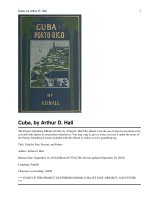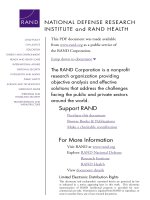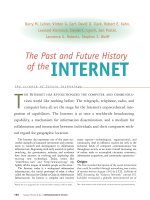Past and Future - Insights for Reserve Component Use potx
Bạn đang xem bản rút gọn của tài liệu. Xem và tải ngay bản đầy đủ của tài liệu tại đây (436.42 KB, 99 trang )
This PDF document was made available from www.rand.org as a public
service of the RAND Corporation.
6
Jump down to document
Visit RAND at www.rand.org
Explore RAND National Security Research Division
View document details
This document and trademark(s) contained herein are protected by law as indicated in a notice
appearing later in this work. This electronic representation of RAND intellectual property is provided
for non-commercial use only. Permission is required from RAND to reproduce, or reuse in another
form, any of our research documents for commercial use.
Limited Electronic Distribution Rights
For More Information
CHILD POLICY
CIVIL JUSTICE
EDUCATIO
N
ENERGY AND ENVIRONMENT
HEALTH AND HEALTH CAR
E
INTERNATIONAL AFFAIR
S
NATIONAL SECURIT
Y
POPULATION AND AGIN
G
PUBLIC SAFETY
SCIENCE AND TECHNOLOGY
SUBSTANCE ABUSE
TERRORISM AND
HOMELAND SECURITY
TRANSPORTATION AND
INFRASTRUCTURE
The RAND Corporation is a nonprofit research
organization providing objective analysis and effective
solutions that address the challenges facing the public
and private sectors around the world.
Purchase this document
Browse Books & Publications
Make a charitable contributio
n
Support RAND
This product is part of the RAND Corporation technical report series. Reports may
include research findings on a specific topic that is limited in scope; present discus
-
sions of the methodology employed in research; provide literature reviews, survey
instruments, modeling exercises, guidelines for practitioners and research profes
-
sionals, and supporting documentation; or deliver preliminary findings. All RAND
reports undergo rigorous peer review to ensure that they meet high standards for re
-
search quality and objectivity.
Past and Future
Insights for
Reserve Component Use
HARRY J. THIE, RAYMOND E. CONLEY,
HENRY A. LEONARD, MEGAN ABBOTT,
ERIC V. LARSON, K. SCOTT M
cMAHON,
MICHAEL G. SHANLEY, RONALD E. SORTOR,
WILLIAM TAYLOR, STEPHEN DALZELL,
ROLAND J. YARDLEY
TR-140-OSD
September 2004
Prepared for the Office of the Secretary of Defense
Approved for public release; distribution unlimited
The RAND Corporation is a nonprofit research organization providing objective analysis
and effective solutions that address the challenges facing the public and private sectors
around the world. RAND’s publications do not necessarily reflect the opinions of its research
clients and sponsors.
R
®
is a registered trademark.
© Copyright 2004 RAND Corporation
All rights reserved. No part of this book may be reproduced in any form by any electronic or
mechanical means (including photocopying, recording, or information storage and retrieval)
without permission in writing from RAND.
Published 2004 by the RAND Corporation
1700 Main Street, P.O. Box 2138, Santa Monica, CA 90407-2138
1200 South Hayes Street, Arlington, VA 22202-5050
201 North Craig Street, Suite 202, Pittsburgh, PA 15213-1516
RAND URL: />To order RAND documents or to obtain additional information, contact
Distribution Services: Telephone: (310) 451-7002;
Fax: (310) 451-6915; Email:
Library of Congress Cataloging-in-Publication Data
Past and future : insights for reserve component use / Harry J. Thie [et al.].
p. cm.
“TR-140.”
ISBN 0-8330-3575-4 (pbk. : alk. paper)
1. United States—Armed Forces—Reserves. 2. United States—Armed Forces—Personnel management.
I. Thie, Harry.
UA42.P37 2004
355.3'7'0973—dc22
2004006786
The research described in this report was sponsored by the Office of the Secretary of Defense
(OSD). The research was conducted in the RAND National Defense Research Institute, a
division of the RAND Corporation and a federally funded research and development center
supported by the OSD, the Joint Staff, the unified commands, and the defense agencies under
Contract DASW01-01-C-0004.
iii
Preface
The 2001 Quadrennial Defense Review (QDR)
1
directed a “comprehensive review of Active
and Reserve mix, organization, priority missions, and associated resources,” requesting that
the review “build on recent assessments of Reserve Component issues that highlighted
emerging roles for the Reserve Components in the defense of the United States, in smaller-
scale contingencies, and in major combat operations.”
On November 27, 2001, Deputy Secretary of Defense Paul Wolfowitz charged the
Under Secretary of Defense for Personnel and Readiness with chairing such a review, re-
questing that the review identify a range of innovative options concerning the active and
reserve force mix and that it address how the mission of the Department of Defense (DoD)
has changed under the new Defense Strategy outlined in the QDR, and how the events of
September 11, 2001, have changed the focus of the Department.
Three major issue areas were to be examined:
1. What role should the Reserve Components play in Homeland Defense?
2. How can the Guard and Reserve support the Department’s transformation efforts?
3. What innovative approaches can be used for Guard and Reserve structure and what
additional capabilities are required to support the full spectrum of mission requirements
from major regional conflicts, smaller-scale contingencies, to peacetime operations?
To conduct this review, the Office of the Secretary of Defense (OSD) requested the
advice and assistance of its federally funded research and development centers (FFRDCs) as
it explored these questions. RAND’s three FFRDCs, Project AIR FORCE (PAF), the Arroyo
Center (the Army’s FFRDC), and the National Defense Research Institute (NDRI) have all
conducted numerous studies germane to the review’s focus. As a result, RAND’s team pro-
vided support for the OSD working groups, conducting the comprehensive review by draw-
ing upon existing research, models and data, and other expertise in homeland security; tradi-
tional warfighting missions across a full spectrum of operations; active and reserve force
organization and management; defense transformation; and other topics.
This report documents the background information, research, and analysis RAND
was asked to provide in support of a comprehensive DoD review of the roles and missions of
the Reserve Components. It thus serves as a partial compendium of the information and
analysis RAND provided for OSD’s working groups—in particular, to the Deputy Assistant
____________
1
Donald H. Rumsfeld, Quadrennial Defense Review Report, Washington, D.C., September 30, 2001, p. 23.
iv Past and Future: Insights for Reserve Component Use
Secretary of Defense (DASD) for Manpower and Personnel and the other DASDs of the
Office of the Assistant Secretary of Defense for Reserve Affairs.
This research was conducted for the Office of the Assistant Secretary of Defense
(Reserve Affairs) within the Forces and Resources Policy Center of the RAND National
Defense Research Institute, a federally funded research and development center sponsored by
the Office of the Secretary of Defense, the Joint Staff, the unified commands, and the
defense agencies.
Comments are welcome and may be addressed to Harry Thie, RAND Corporation,
1200 South Hayes Street, Arlington, Virginia 22202, or For more in-
formation on RAND’s Forces and Resources Policy Center, contact the Director, Susan
Everingham. She can be reached at 1700 Main Street, Santa Monica, California 90401, or
by e-mail: , or by phone: 310-393-0411, extension 7654. More
information about RAND is available at www.rand.org.
v
The RAND Corporation Quality Assurance Process
Peer review is an integral part of all RAND Corporation research projects. Prior to
publication, this document, as with all documents in the RAND technical report series, was
subject to a quality assurance process to ensure that the research meets several standards,
including the following: The problem is well formulated; the research approach is well
designed and well executed; the data and assumptions are sound; the findings are useful and
advance knowledge; the implications and recommendations follow logically from the
findings and are explained thoroughly; the documentation is accurate, understandable,
cogent, and temperate in tone; the research demonstrates understanding of related previous
studies; and the research is relevant, objective, independent, and balanced. Peer review is
conducted by research professionals who were not members of the project team.
RAND routinely reviews and refines its quality assurance process and also conducts
periodic external and internal reviews of the quality of its body of work. For additional
details regarding the RAND quality assurance process, visit:
/>
vii
Contents
Preface iii
Figure and Tables
ix
Summary
xi
Acknowledgments
xiii
Acronyms
xv
CHAPTER ONE
Introduction 1
CHAPTER TWO
RAND White Paper No. 1
U.S. Strategic Ballistic Missile Defense: Options for Reserve Component Support
5
Preface
5
Background
5
The Army’s Ground-Based Midcourse Defense
6
AC/RC Analysis
7
The Navy’s Sea-Based Ballistic Missile Defense
8
AC/RC Analysis
11
The Air Force’s Airborne Laser Ballistic Missile Defense
11
AC/RC Mix Analysis
13
Conclusion
14
CHAPTER THREE
RAND White Paper No. 2
Homeland Security
15
Preface
15
Issues
15
Background
16
Addressing the Issues
17
Prioritization of HLS Mission Areas
17
Apportionment and Mission Assignment
23
Ensuring Homeland Security While Preserving Other Capabilities
24
Making Civil Support Capabilities Available Quickly
25
Considering Major Factors in Developing AC/RC Policies for HLS
25
viii Past and Future: Insights for Reserve Component Use
Development of Options 26
Prioritizing HLS Mission Areas
26
Apportioning Assets and Assigning Mission
27
Ensuring Homeland Security While Preserving Other Capabilities
27
Making Civil Support Capabilities Available Quickly
29
Recommendations
29
Prioritize HLS Mission Areas
29
Apportion and Assign Forces for HLS Mission Areas
30
Ensure Homeland Security While Preserving Other Capabilities
30
Make Civil Support Capabilities Available Quickly
31
Consider Major Factors in Developing AC/RC Policies for HLS
31
CHAPTER FOUR
RAND White Paper No. 3
Improving Fighter Pilot Manning and Absorption
33
Preface
33
Issue
33
Background
34
Development and Discussion of Options
37
Recommendation
39
CHAPTER FIVE
RAND White Paper No. 4
Potential RC Contributions to Smaller-Scale Contingencies
41
Preface
41
Issue
41
Background
41
Development and Discussion of Options
45
Recommendations
46
APPENDIX
A. Selected Past RAND NDRI Research on Reserve Components 47
B. Selected Past RAND Arroyo Center Research on Reserve Components
52
C. Selected Past RAND Project AIR FORCE Research on Reserve Components
61
D. Abstracts of Relevant RAND Research
63
ix
Figure and Tables
Figure
4.1. Active Fighter PAA Reductions Are Central to Current Absorption Problems 34
Tables
2.1. Preliminary Estimate of ABL Squadron Operations and Support Personnel 12
3.1. A Taxonomy of Homeland Security Mission Areas
18
xi
Summary
The Quadrennial Defense Review, released in September 2001,
1
expresses concern about the
current readiness of its operational units. Post–Cold War downsizing and widespread budget
cuts have occurred side by side with intensive deployment and operational-tempo
demands⎯ conditions that have translated into a growing reliance on the Reserve
Components (RC). The reserves now play a far more substantial role in military contingen-
cies, including peacekeeping and humanitarian missions, and the military’s reliance on the
reserves is only expected to grow.
The QDR’s new vision thus raises many questions about the most appropriate
balance of capabilities between active and reserve forces and about the possible need for
changes in how the Reserve Components are used. All told, the QDR notes that, as the mili-
tary’s transformation takes shape, DoD will continue to rely on reserve forces to help in new
restructuring and reorganization opportunities. In particular, the QDR (2001, p. 23) man-
dated a “comprehensive review of Active and Reserve mix, organization, priority missions,
and associated resources.”
To take on these questions, the Office of the Assistant Secretary of Defense for
Reserve Affairs formed a review team that included a number of groups and individuals in-
side and outside the Department of Defense (DoD), such as experts from the military serv-
ices and researchers from federally funded research and development centers (FFRDCs). To
help conduct the review, the team asked RAND’s FFRDCs—Project AIR FORCE (PAF),
the Arroyo Center (the Army’s FFRDC), and the National Defense Research Institute
(NDRI)—to provide support in two areas: reviewing existing research and formulating new
ideas for topics identified by the review team.
Initially, RAND researchers supplied this information in three forms: as briefings of
past research, as excerpts of relevant portions of past research, and as several “white papers”
that either expand on past research or advance new insights for RC use. These white papers
form the centerpiece of this document. Although not designed to be comprehensive or com-
plete, these papers are think pieces commissioned in particular areas by the sponsor. They
focus on the potential role of RC support in the following areas:
• Strategic ballistic missile defense programs, or ways the RC or new active/reserve force
mixes may help in the operation of the new Ballistic Missile Defense System.
• Homeland security operations, including possible roles for the Reserve Component in
the CONUS (continental United States) Air Defense mission and Civil Support mis-
____________
1
Donald H. Rumsfeld, Quadrennial Defense Review Report, Washington, D.C., September 30, 2001.
xii Past and Future: Insights for Reserve Component Use
sions, how apportionment and mission assignment might best proceed, and how best
to ensure homeland security while preserving other RC capabilities.
• Manning and absorption problems—specifically, ways to use the RC or blended Active
Component (AC)/RC units to enhance absorption rates (ability to absorb inexperi-
enced pilots into operational flying positions while meeting pilot experience goals) in
units in need, such as AC fighter pilots.
• Smaller-scale contingency operations, or the possible use of RC personnel in deploy-
ments smaller than major theater wars (e.g., peacekeeping operations) in order to
alleviate the burden on AC units and perhaps make better use of the range of skills
available in the reserves.
Although these papers cover diverse topics, they are all linked by a common purpose:
to provide OSD with an expansive range of considerations and alternatives for the prospec-
tive use of the reserve forces in the military of the future. As such, these papers raise key
issues, point to and explore past studies and analyses, and offer recommendations for further
research.
xiii
Acknowledgments
We are grateful for the assistance, facilitation, and interactions provided by our sponsor,
Dr. John Winkler, during the course of this research. The report also benefited from the
assistance of many colleagues at the RAND Corporation, including Robin Cole and Sonia
Nagda. An earlier draft was improved significantly through the contributions of our
reviewers, David Oaks and Roger Brown.
xv
Acronyms
ABL Airborne Laser
AC Active Component
ACC Air Combat Command
AD active duty
ADSC active-duty service commitment
AEF Aerospace Expeditionary Force
AEW Aerospace Expeditionary Wing
AFB Air Force Base
AFRC Air Force Reserve Command
AFSC Air Force Specialty Codes
AGR Active Guard and Reserve
API Aircrew Position Indicator
ARG Amphibious Ready Group
ARNG Army National Guard
ASD average sortie duration
AWACS Airborne Warning and Control System
BMD ballistic missile defense
BMDS Ballistic Missile Defense System
BTR bonus-take rate
CAF Combat Air Forces
CBO Congressional Budget Office
CBRN chemical, biological, radiological, or nuclear
CBRNE chemical, biological, radiological, nuclear, and high-
yield explosives
COG continuity of government
CONOPS concept of operations
CONUS continental United States
CRAF Civil Reserve Air Fleet
CS Civil Support
xvi Past and Future: Insights for Reserve Component Use
CST Civil Support Team
CVBG naval carrier battle group
DASD Deputy Assistant Secretary of Defense
DCSOPS Deputy Chief of Staff for Operations
DD(X) destroyer
DoD Department of Defense (U.S.)
EAF Expeditionary Aerospace Force
EMT Emergency Medical Team; emergency medical
technician
EP Emergency Preparedness
FBI Federal Bureau of Investigation
FEMA Federal Emergency Management Agency
FPCON Force Protection Condition
FTF Future Total Force
FWE fighter wing equivalent
FY fiscal year
GMD Ground-Based Midcourse Defense
HLD homeland defense
HLS homeland security
IDA Institute for Defense Analysis
IDO initial defensive operations
IO Information operations
IP instructor pilot
ISR intelligence, surveillance, and reconnaissance
JCS Joint Chiefs of Staff
JSTARS Joint Surveillance and Target Attack Radar System
LFA Lead Federal Agency
LIMEX limited experience
MAGTF Marine Air-Ground Task Force
MEU Marine Expeditionary Unit
MFO Multinational Force and Observers
MP Military Police
MTW Major Theater War
NGB-MD National Guard Bureau Missile Defense Office
NORAD North American Air Defense Command
NORTHCOM Northern Command
NSSE National Security Special Events
Acronyms xvii
OASD(RA) Office of the Assistant Secretary of Defense for
Reserve Affairs
OCONUS outside the continental United States
OOTW Operations Other Than War
OSD Office of the Secretary of Defense
PAA primary aircraft authorization
PSRC Presidential Selected Reserve Call-up
QDR Quadrennial Defense Review
RC Reserve Component
RCE-05 Reserve Component Employment 2005
RDT&E Research, Development, Test, and Evaluation
SMDC Space and Missile Defense Command
SSC smaller-scale contingency
TASS Total Army School System
TFAP Total Force Absorption Policy
TPFDD Time-Phased Force and Deployment Data
TTE time-to-experience
UPT Undergraduate Pilot Training
USAR U.S. Army Reserve
UTE aircraft utilization
WMD weapons of mass destruction
1
CHAPTER ONE
Introduction
In a December 2002 Pentagon Town Hall Meeting with several of the Under Secretaries of
Defense, the Undersecretary of Defense for Personnel and Readiness, David Chu, was asked
to address the Department of Defense’s (DoD’s) vision for the future use and integration of
the reserve forces. Under Secretary Chu replied,
We see the reserve forces as an indispensable part of the total military posture of this
department. As you know, in the Cold War, the department had one vision of what
they were, which was largely a mirror image of the active force. And I think, while
we’re still debating this proposition, we’re increasingly seeing them as a comple-
ment. . . . It doesn’t mean there wouldn’t be stand-alone and reserve units, but that
there would be much closer integration over time between . . . so-called active and
reserve forces.
Dr. Chu’s comments reflect widespread changes in the way military planners perceive
the role of the reserve forces. These changes accelerated as the U.S. military embarked on its
force transformation, a transformation that has become more focused and substantially more
complicated since the events of September 2001.
In fact, less than three weeks after the September 11, 2001 (“9/11”) attack on the
United States, the U.S. Department of Defense released its much-anticipated Quadrennial
Defense Review (QDR),
1
a top-down look at the nation’s defense strategy. As set forth in
Secretary of Defense Donald Rumsfeld’s introduction, the QDR placed particular emphasis
on shifting the nation’s military from a “threat-based” model to a “capabilities-focused” one.
In other words, the future military will focus less on identifying who might pose a threat, and
more on how the United States might be endangered. Ultimately, the goal is to create a more
flexible force prepared for the demands posed by new and diverse adversaries.
The Quadrennial Defense Review released in September 2001 expresses concern
about the current readiness of its operational units. Post–Cold War downsizing and wide-
spread budget cuts have occurred side by side with intensive deployment and operational-
tempo demands⎯ conditions that have translated into a growing reliance on the Reserve
Components (RCs): the Army National Guard, the Army Reserve, the Naval Reserve, the
Marine Corps Reserve, the Air National Guard, the Air Force Reserve, and the Coast Guard
Reserve. Indeed, reserve support multiplied from 1.4 million duty days in fiscal year (FY)
1989 to almost 13 million in FY2001.
2
____________
1
Donald H. Rumsfeld, Quadrennial Defense Review Report, Washington, D.C., September 30, 2001.
2
Office of the Assistant Secretary of Defense for Reserve Affairs, Review of Reserve Component Contributions to National
Defense, Washington, D.C., December 20, 2002, p. vii.
2 Past and Future: Insights for Reserve Component Use
In a departure from their past role as a supplemental force used almost exclusively for
low-probability/high-intensity conflicts, the reserves now play a far more substantial role in
military contingencies, including peacekeeping and humanitarian missions. Further, because
the Active Component (AC) has been reduced in recent years at a higher rate than have the
reserves, the RC has become a readily available means by which to reduce stress in the active
forces as they seek to keep up with heightened operational tempos. In addition, the reserve
forces offer valuable capabilities, such as civil engineering expertise, weather flights, and air
traffic control, that are in comparatively short supply in the AC.
3
This reliance on the reserves is only expected to grow now that homeland security has
become a critical priority; for instance, as DoD places increasing emphasis on
counterterrorism training for federal, state, and local first responders, they will need to call
upon the capabilities of the reserves and the National Guard.
The QDR’s new vision thus raises many questions about the most appropriate
balance of capabilities between active and reserve forces and about the possible need for
changes in how the Reserve Components are used. All told, the QDR notes that, as the mili-
tary’s transformation takes shape, DoD will continue to rely on reserve forces to help in new
restructuring and reorganization opportunities. In particular, the QDR mandated a
“comprehensive review of Active and Reserve mix, organization, priority missions, and asso-
ciated resources.” On November 27, 2001, two months after the QDR was released, Deputy
Secretary of Defense Paul Wolfowitz directed the Under Secretary of Defense for Personnel
and Readiness to chair such a review. The intent was to build on recent assessments suggest-
ing promising roles for the Reserve Components in the nation’s defense, from small-scale
contingencies to major combat operations. Further, the review would identify a range of new
options concerning the active and reserve force mix. It would also address how the mission of
DoD has changed under the new defense strategy as outlined in the QDR, and how the
events of September 11, 2001, have changed the focus of the Department.
The review was designed to tackle three major questions:
• What role should the RCs play in homeland defense?
• How can the Guard and Reserve support the Department’s transformation efforts?
• What innovative approaches can be used for Guard and Reserve structure and what
additional capabilities are required to support the full spectrum of mission require-
ments from major regional conflicts, smaller-scale contingencies, and peacetime
operations?
To take on these questions, the Office of the Assistant Secretary of Defense for
Reserve Affairs formed a review team that included a number of groups and individuals in-
side and outside DoD, such as experts from the military services and researchers from
federally funded research and development centers (FFRDCs). To help conduct the review,
the team asked RAND’s FFRDCs—Project AIR FORCE (PAF), the Arroyo Center (the
____________
3
Under Secretary Chu commented during the aforementioned December 2002 Town Hall Meeting,
I think we see the Reserves as a terrific way to reach talent in the civil sector that we really cannot grow, should not try to
grow, necessarily, in large numbers in the active force. I’ll offer information technology as an example of that, but also cer-
tain types of medical skills; trauma surgery, for example, is another kind of thing that exists in the civil sector that’s hard for
us.
Introduction 3
Army’s FFRDC), and the National Defense Research Institute (NDRI)—to provide support
in two areas: reviewing existing research and formulating new ideas for topics identified by
the review team.
Specifically, RAND’s role was to assist the Office of the Secretary of Defense (OSD)
working groups conducting the review by drawing upon existing research, models and data,
and other expertise in homeland security; traditional warfighting missions across a full spec-
trum of operations; active and reserve force organization and management; defense transfor-
mation; and other topics. Forms of support included the following:
• Identifying potential RC roles in homeland defense and traditional missions by
drawing from and expanding upon RAND’s research on active/reserve force-mix
alternatives.
• Conducting short-term analyses of possible homeland security and traditional mis-
sion alternatives employing RC forces, using existing data or models.
• Participating in “red teams” focused on challenging RC roles in homeland security
and traditional missions.
• Contributing to working group discussions and deliberations.
• Examining longer-term homeland security and traditional mission/RC issues that the
review identified as being in need of further study.
The purpose of this report is to summarize the information we ultimately provided
to the review team—in particular, to the Deputy Assistant Secretary of Defense (DASD) for
Manpower and Personnel and the other DASDs of the Office of the Assistant Secretary of
Defense for Reserve Affairs.
The organization of the report is as follows. The next four chapters correspond to the
white papers and accompanying prefaces explaining their context and intent. Following these
four central papers, we include an omnibus of selected past RAND research studies relevant
for the RC review. We begin with selected summaries of the results of pertinent NDRI
(Appendix A), Arroyo Center (Appendix B), and Project AIR FORCE (Appendix C)
research.
4
Finally, we present an extensive bibliography of the last 10 years of RAND
research on reserve forces. In total, these appendices encompass only areas of particular inter-
est to the sponsor, not all RAND research touching on the reserves. These appendix over-
views, excerpts, and summaries are not meant to be exhaustive, nor are they meant to be in-
depth analyses of the various connections between these original research projects and the
four white papers or the RC review for which the white papers were prepared. Instead, they
serve to demonstrate the interests of our sponsor—the information and background OSD
sought from us in formulating its comprehensive review.
This document should serve as a useful compendium of our contribution to DoD’s
exploration of the potential future roles of its reserve forces, as a part of a major reevaluation
of the roles of active and reserve forces and their roles and responsibilities vis-à-vis each other.
____________
4
Not included in this report are two direct excerpts from a RAND study, B. Rostker et al., Assessing the Structure and Mix
of Future Active and Reserve Forces: Final Report to the Secretary of Defense, Santa Monica, Calif.: RAND Corporation,
MR-140-1-OSD, 1992, that were specifically requested by our sponsor for consideration of proposals under discussion. The
excerpts—Appendix C and Appendix F in that study—discuss, respectively, the Army’s “roundout” concept to integrate
active and reserve soldiers in a single unit and the Air Force’s “associate” unit concept, which involves the use of reserve
crews to complement an active unit.
5
CHAPTER TWO
RAND White Paper No. 1
U.S. Strategic Ballistic Missile Defense:
Options for Reserve Component Support
K. Scott McMahon, with LTC Stephen Dalzell (U.S. Army),
Ray Conley, and Roland Yardley
Preface
Following its withdrawal from the 1972 Anti-Ballistic Missile Treaty in June 2002, the United
States announced plans to pursue a variety of strategic ballistic missile defense (BMD) projects that
had been prohibited by the treaty. The United States intends to develop a networked system of
sea-, air-, land-, and space-based BMD components; the system will require contributions from all
of the military services. This prospect affords planners an opportunity to consider new AC/RC
force-mix options to operate the defense system. The Army plans to make extensive use of National
Guard Active Guard Reserve personnel to operate the Ground-Based Midcourse Defense system.
The Air Force is evaluating the future use of Air National Guard personnel to support the first
Airborne Laser test aircraft. An option for participation by Naval Reservists could emerge in the
future as the Navy experiments with and refines its approach to rotating crews to forward-
deployed ships. It seems clear that, with proper and timely training for the BMD mission, RC
personnel could support many activities, thus also demonstrating their potential to support other
complex strategic weapon systems in the U.S. arsenal. The following paper, prepared in June
2002, pursues these possibilities.
It is now widely recognized that the proliferation of strategic-range ballistic missiles
constitutes an emerging threat to U.S. territory. DoD is currently pursuing a diverse research
and development program to examine options for a Ballistic Missile Defense System
(BMDS) to protect the 50 United States, as well as U.S. territories, military forces, and allies.
President George W. Bush’s recent decision to withdraw from the 1972 Anti-Ballistic Missile
Treaty with Russia permits the development of homeland missile defense options prohibited
during the Cold War. We describe potential elements of a future BMDS architecture that
could be developed through 2012—the Army’s Ground-Based Midcourse Defense, the
Navy’s Sea-Based Ballistic Missile Defense System, and the Air Force’s Airborne Laser—and
options for using Active Component (AC) and Reserve Component (RC) manpower to
operate and support these future defense systems.
Background
The Bush Administration is currently focusing the strategic elements of its BMDS program
on countering limited strikes—by “handfuls of missiles,” the Secretary of Defense has









